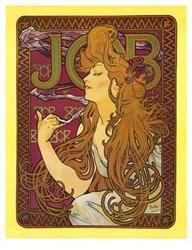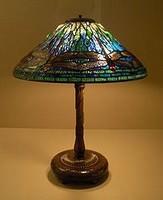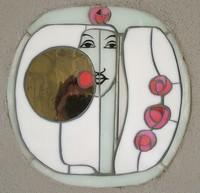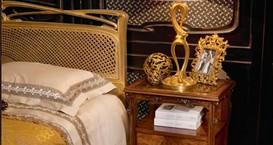Art Nouveau
Post from EditorialsArt Nouveau has assumed different names and was turned down in many ways, when was chosen as the original style for new forms in architecture and interior decor.
 It is a style still not often present in current furnishings, modern or classic. Only a few examples, mostly lamps, chairs and small pieces of furniture.
It is a style still not often present in current furnishings, modern or classic. Only a few examples, mostly lamps, chairs and small pieces of furniture.
Art Nouveau seems to be a niche style, to be inserted in small quantities, aesthetically as breaking elements in a context of minimal-chic modern decor, or as enhancement for classical interiors, in which the classic Tiffany lamp cannot be missing.
When, however, Art Nouveau is chosen as the dominant style of furniture for the entire house, then it is a difficult and weighted up choice, but with original and very elegant result. 
Few companies propose this style, some taking up its formal characteristics for modern productions, other still reproducing historical collector's items.
The Art Nouveau Style was born as a reaction to Eclecticism, that, with its virtuosity, emphasized the use of all classic decorative heritage, made of capitals, putti, mouldings and animals' legs, sometimes all together in one cabinet. This was the situation in the years between the end of '800 and early '900, when this style reached its peak.
In England, William Morris, aware of the new social reality generated by the Industrial Revolution, plans to create a type of product for furniture that is available to everyone, but with an aesthetic value so far inconceivable for a popular art. His Gothic Style furniture, chosen because it seemed the most appropriate style as regarded these ideas, however, were still made by hand, by skilled craftsmen who used precious and expensive wood, certainly not within the reach of the common people whom Morris wanted to contact.
His Gothic Style furniture, chosen because it seemed the most appropriate style as regarded these ideas, however, were still made by hand, by skilled craftsmen who used precious and expensive wood, certainly not within the reach of the common people whom Morris wanted to contact.
It was, however, his innovative thinking of a new way of popular living to indicate the main road to the future industrial design. The distinctive features of the new style that was emerging, consisting of clean lines and stylized decorative elements, were taken up and developed by talented artists such as Voysey and Mackintosh, who created some prototypes perhaps too far ahead of their time.
They did not meet, in fact, among their contemporaries, the same success that, instead, other artists met in the rest of Europe, where the new style developed with an irrepressible enthusiasm. In England this style was called Modern Style, while it was called Jugendstil in Germany, Secession in Austria, Modernism in Spain.
In France and Belgium it was called Art Nouveau (the name of the store who first proposed Art Nouveau style objects and furniture), in Italy it was called Floral Style, or Liberty (again, a name taken from a London shop).
In comparison with those style products, Mackintosh's Modern Style proposed tighter lines, almost abstract lines. For the furniture, he used poor materials, such as natural wood, and straw for chairs. Ahead of his time, actually those ones represented the same forms proposed again by modern designers.
Many compare Art Nouveau to Rococo, especially for elegance and creativity. The inspiration for the forms is derived directly from nature, from plant forms, represented at the very time of flowering, life in the moment of growth. Lines are sinuous, wavy (the so called whiplash), phytomorphic, as well as edges are abolished.
Everything is movement, burst  to the new way of life, that is no more than a moment captured immediately before further movement. Flowers and plants are always represented as under the action of wind and storms.
to the new way of life, that is no more than a moment captured immediately before further movement. Flowers and plants are always represented as under the action of wind and storms.
Other topics, such as butterflies and stylized birds are in motion, mingled with the waves generated by other vegetation. The female figures are wrapped in their flowing locks of hair, which seem to be lianes. Mahogany and walnut are the most used kinds of wood, in addition to the steam bent beech-wood, while other species are used for inlay works.
Art Nouveau, ultimately, was born as a revolutionary style, with the intention of saving techniques and qualities of classical arts of the past, but, at the same time, getting free from their formal and decorative features: structure and decoration are no longer separate entities (let's only consider the contribution of Gaudi in Spain, where the structure itself became decoration for the whole building).
However, not always this style succeeded in  this intention, difficult to implement because the new industrial production methods hardly managed to ensure optimal quality and aesthetics that only clever artisans could provide.
this intention, difficult to implement because the new industrial production methods hardly managed to ensure optimal quality and aesthetics that only clever artisans could provide. .jpg)
Do not forget that it was only later, after World War I, that we were freed from utopian tendency of wanting to save at all costs some formalisms, saving the spirit of this new style, this way meeting new production requirements.
Let's also consider that, precisely because of the Great War, Art Nouveau had no way to spread properly, and in fact it was scorned by the people for which it was born, which continued to prefer the more traditional forms of neo-Renaissance and Neo-Baroque styles.
Still, when you choose a classic design, you think of other art movements, rather than this. The niche connoisseur knows, however, this style, and the market has had returns of its success as early as the second half of the 70s and 80s of the last century.
arch. Raffaella Pierri
79870 REGISTERED USERS










